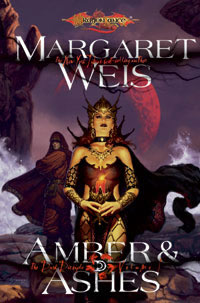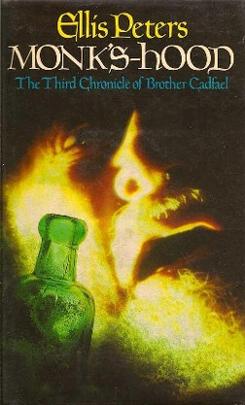Plot
In 2043 Stephen Samson, a representative of the Miracle Meal Corporation, comes to visit the Rev. Malachi Pennyhorse, whose rural church in Wiltshire, England, includes the remains of a now defunct monastery. Samson's company proposes to set up a factory for Miracle Meal, a meal-in-a-can product, using the old buildings, as part of his company's policy to provide a beneficial environment for workers while fitting in with the landscape. Observing them are the ghostly remains of Brother James and Brother Gregory, who perished from plague in the 12th century. Brother Gregory is intelligent and learned, and has used his ability to physically manifest himself to study from the local village library. He speaks of their confinement to the earthly plane in scientific terms, while Brother James has only read Lives of the Saints.
After production begins, the two hatch a scheme to sabotage it. Brother Gregory has realized that they have the power to send objects back in time. After each day's production they send the entire batch back to when they were alive, much to the gratitude of the monks then, who regard the sudden appearance of delicious nutritious food as a miracle. They live in the time of the Anarchy, when rival claimants to the throne sent their armies across the land, disrupting society and the food supply. The miraculous appearance of the food causes thousands of people to come to the monastery.
Rev. Pennyhorse, who has long known of the ghosts, is not surprised at the mysterious happenings. The company sends in a scientist, Sidney Meredith, who has enough equipment to detect the ghosts, something Brother Gregory quickly realizes. They establish communication of a sort, and Meredith is able to understand how they sent the food back in time. As he relates to the Rev. Pennyhorse later, he persuaded the Brothers to stop interfering by pointing out that their ability could be harnessed in a different way. Acting together, they warped space and time to become, as Brother Gregory put it, "Translated". They roam free among the stars, where Brother Gregory occupies his time observing "the integration of helium".

Benedict of Nursia, often known as Saint Benedict, was an Italian Christian monk, writer, and theologian who is venerated in the Catholic Church, the Eastern Orthodox Church, the Oriental Orthodox Churches, the Anglican Communion, and Old Catholic Churches. He is a patron saint of Europe.

Columbanus was an Irish missionary notable for founding a number of monasteries after 590 in the Frankish and Lombard kingdoms, most notably Luxeuil Abbey in present-day France and Bobbio Abbey in present-day Italy.

Pachomius, also known as Saint Pachomius the Great, is generally recognized as the founder of Christian cenobitic monasticism. Coptic churches celebrate his feast day on 9 May, and Eastern Orthodox and Roman Catholic churches mark his feast on 15 May or 28 May. In the Lutheran Church, he is remembered as a renewer of the church, along with his contemporary, Anthony of Egypt on 17 January.

The Rule of Saint Benedict is a book of precepts written in Latin c. 530 by St Benedict of Nursia for monks living communally under the authority of an abbot.

The Carthusians, also known as the Order of Carthusians, are a Latin enclosed religious order of the Catholic Church. The order was founded by Bruno of Cologne in 1084 and includes both monks and nuns. The order has its own rule, called the Statutes, and their life combines both eremitical and cenobitic monasticism. The motto of the Carthusians is Stat crux dum volvitur orbis, Latin for "The Cross is steady while the world turns". The Carthusians retain a unique form of liturgy known as the Carthusian Rite.

Neot was an English monk. Born in the first half of the ninth century, he lived as a monk at Glastonbury Abbey. He preferred to perform his religious devotions privately, and he later went to live an isolated life in Cornwall, near the village now called St Neot. His wisdom and religious dedication earned him admiration from the monks. He visited the Pope in Rome, who instructed him to found a monastery in Cornwall.

A monk is a person who practices religious asceticism by living a monastic lifestyle, either alone or with any number of other monks. A monk may be a person who decides to dedicate their life to serving other people and serving God, or to be an ascetic who voluntarily chooses to leave mainstream society and live their life in prayer and contemplation. The concept is ancient and can be seen in many religions and in philosophy.

Christian monasticism is the devotional practice of Christians who live ascetic and typically cloistered lives that are dedicated to Christian worship. It began to develop early in the history of the Christian Church, modeled upon scriptural examples and ideals, including those in the Old Testament, but was not mandated as an institution in the scriptures. It has come to be regulated by religious rules and, in modern times, the Canon law of the respective Christian denominations that have forms of monastic living. Those living the monastic life are known by the generic terms monks (men) and nuns (women). The word monk originated from the Greek μοναχός, itself from μόνος meaning 'alone'.
Post Consumer Brands is an American breakfast cereal manufacturer headquartered in Lakeville, Minnesota.

Maurus (512–584) was the first disciple of Benedict of Nursia. He is mentioned in Gregory the Great's biography of the latter as the first oblate, offered to the monastery by his noble Roman parents as a young boy to be brought up in the monastic life.

Amber and Ashes is a fiction, fantasy novel in the Dragonlance book series and is the first of a trilogy called "The Dark Disciple", based around the character Mina. The book takes up where the War of Souls left off. This trilogy will explore the Chaos that is post-war Krynn. It is authored by Margaret Weis, who was a co-founder of the Dragonlance series, along with Tracy Hickman. This is Weis's fourteenth novel in the series, and first solo hardcover since the publication of the extremely popular Dragonlance title The Soulforge in 1998.

Chosen of the Gods is a fantasy novel set in the Dragonlance campaign series, and is the first of a trilogy about the Kingpriest of Istar, Beldinas Pilofiro.

Miracle of Marcelino is a 1955 Spanish film written by José Maria Sanchez-Silva, based on his novel, and directed by Ladislao Vajda. It starred, Juan Calvo and the young child star Pablito Calvo as Marcelino. The musical score and theme song – sung in full during the action, rather than at the start of the film – are by Pablo Sorozábal.
"Villains" is the eighth episode of the third season of the NBC superhero drama series Heroes and forty-second episode overall. Instead of the usual title screen with the show's name it uses a similar screen, replacing the word "Heroes" with the episode's name.

Monk's-Hood is a medieval mystery novel by Ellis Peters, set in December 1138. It is the third novel in The Cadfael Chronicles. It was first published in 1980.
Pac-Man and the Ghostly Adventures, also known in Japan as Pac-World, is a computer-animated television series produced by 41 Entertainment, Arad Productions, a partnership between Sprite Animation Studios and OLM, Inc., and Bandai Namco Entertainment for Tokyo MX, BS11 and Disney XD. Based on Bandai Namco's Pac-Man video game franchise, it is the second animated series to be based upon the game franchise, following the 1982 TV series. The show aired from June 15, 2013, to May 25, 2015, running for two seasons and 52 episodes.

Saint Gregory of Dekapolis or Gregory Dekapolites was a 9th-century Byzantine monk, notable for his miracle-working and his travels across the Byzantine world. He is known as "the New Miracle-Worker", and his feast day in the Eastern Orthodox Church and Roman Catholic Church is on November 20.
Peter Phillips was a British writer known for a series of science fiction stories published between 1948 and 1958. His best known story is Dreams Are Sacred (1948), an early example of a shared dream story facilitated by a device. Phillips wrote another highly regarded story the following year, Manna. This tale involves the ghosts of medieval monks trapped in an old monastery; they are able to benefit from a modern canned super-food thanks to blurred timelines, and engage in poltergeist activity. Like many of the author's works, this story is written with a great deal of humour. Both of these stories have been anthologised on numerous occasions, most recently in 2019.
Saints and animal/plant life. A number of Christian saints have anecdotes and stories about them in relation to animals or plants. In some cases they appeared to possess miraculous powers to speak with animals.

The College of Sant'Anselmo is an international Benedictine college founded by Pope Leo XIII in 1887 and located in Rome, Italy. Situated on the Aventine Hill, it is one of four Benedictine institutions that occupy the complex known as "Sant'Anselmo all'Aventino" which serves as the Primatial Abbey of the Benedictine Confederation. As an ecclesiastical residential college in the Roman College tradition, it serves as both a house of formation for Benedictines, but also as a residence for over one hundred monks from around forty countries, religious, diocesan priests, and lay people. It offers a monastic environment for those who study at the onsite Pontifical Athenaeum of Saint Anselm or at other Roman pontifical universities.














